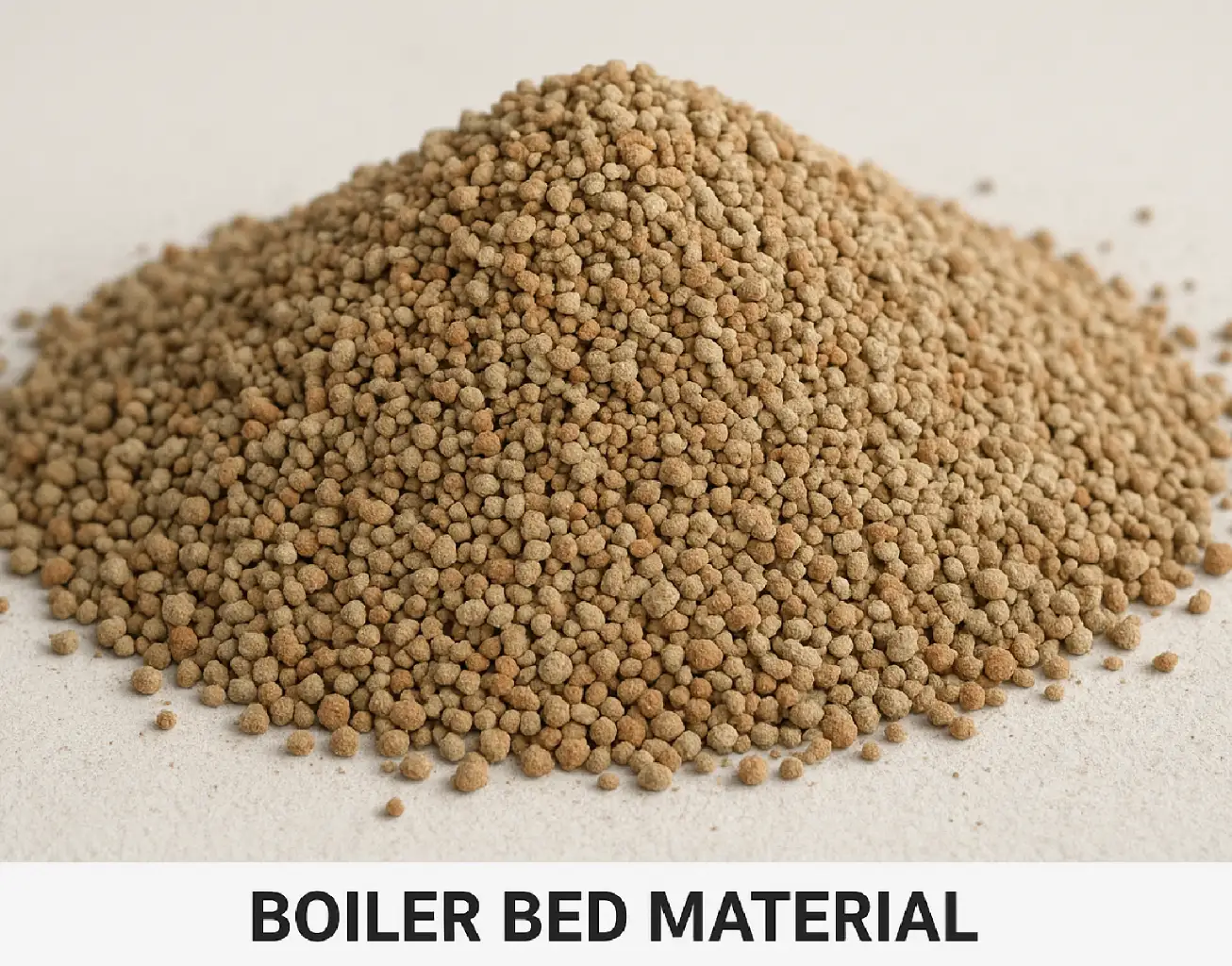When it comes to industrial boilers, especially fluidized bed systems, one element often determines the difference between smooth operations and costly downtime and that is the choice of boiler bed material types.
These aren’t random particles to toss about in a combustion chamber. These are all selected materials based on the connectivity they have for the combustion fuel consumption rate, heat transfer rate, and ultimately the allowable slippage of fire for extended use of the boiler. And considering sand, it has served operators reasonably well over the years as a low-cost material that is readily available.
Although sand still holds value as a boiler bed material, modern industrial applications have broadened limits for engineered options. A good example is using engineered Ceramic Boiler Bed Material, proven to have the proper thermal efficiency and durability that will reduce downtime for maintenance.
In the following boiler bed guide, we will give examples of the many types of boiler bed materials and applications, and we will provide assistance in letting you know which is likely to provide optimal performance for your boiler system.
Specifications: The Building Blocks of a Resilient Bed
Refractory boiler bed material is defined by a set of stringent specifications that ensure it can perform under duress. These are not generic sands but are precisely engineered granules with specific properties:
- High Melting Point:
- The primary characteristic is an exceptionally high softening or melting point, typically well above 1600°C, to prevent sintering and agglomeration at operating temperatures.
- Particle Size and Distribution:
- It is important to have carefully graded sizes (normally, 0.1mm to 1.0mm). A uniform particle size distribution will allow for adequate fluidization, which is when solid particles act like a fluid when air and passes through them.
- High Hardness and Abrasion Resistance:
- The constant violent movement of the bed will require maximum hardness (measured on the Mohs scale) to reduce the effect of attrition and produce less fine dust.
- Chemical Inertness:
- The material must be chemically inert so that reactions do not occur with the fuels, the ash or other products of combustion (especially on the issue of corrosion and bed contamination).
- High Thermal Capacity and Conductivity:
- To achieve efficient heat exchange, heat must be transferred to the water walls and the boiler tubes. Therefore, the materials must exhibited thermal properties that are reasonable.
Get To Know About Various Boiler Bed Material Types
Refractory boiler bed material is defined by a set of stringent specifications that ensure it can perform under duress. These are not generic sands but are precisely engineered granules with specific properties:
- High Melting Point:
- The primary characteristic is an exceptionally high softening or melting point, typically well above 1600°C, to prevent sintering and agglomeration at operating temperatures.
- Particle Size and Distribution:
- It is important to have carefully graded sizes (normally, 0.1mm to 1.0mm). A uniform particle size distribution will allow for adequate fluidization, which is when solid particles act like a fluid when air and passes through them.
- High Hardness and Abrasion Resistance:
- The constant violent movement of the bed will require maximum hardness (measured on the Mohs scale) to reduce the effect of attrition and produce less fine dust.
- Chemical Inertness:
- The material must be chemically inert so that reactions do not occur with the fuels, the ash or other products of combustion (especially on the issue of corrosion and bed contamination).
- High Thermal Capacity and Conductivity:
- To achieve efficient heat exchange, heat must be transferred to the water walls and the boiler tubes. Therefore, the materials must exhibited thermal properties that are reasonable.
Get To Know About Various Boiler Bed Material Types
The choice of which types of boiler bed material to use is an important decision dictated by fuel type, boiler design and operating temperature. The main types are:
1. Silica Sand: The most common, cheapest and widely used material for application at low temperatures. Silica sand has adequate fluidization characteristics; however, it can have agglomeration issues, especially when burning fuels that had high alkali contents which can create low melting eutectics.
2. Ceramic Boiler Bed Material: A superior class of engineered materials used to overcome the disadvantages of silica sand. Key usable boiler bed material types in this class include:
3. Calcined Kaolin (Alumina-Silicate): Has higher resistance to agglomeration and higher operating temperatures than silica sand because of the alumina content.
4. Magnesite-Based Materials: These materials only have very specific uses related to resistance against some corrosive components of ash.
5. Specialty Synthetic Ceramics: These materials are high performance materials designed for extreme environments and will have excellent resistance to abrasion, agglomeration and thermal shock.
Moving from basic silica sand to an advanced Ceramic Boiler Bed Material will allow for more operational reliability and for reduced downtime.
Uses and Benefits Are More Than Just a Bed
The refractory boiler bed material serves multiple indispensable functions:
- Facilitating Fluidization: The refractory aggregate creates the “fluidized bed” that allows for mixing of fuel and air as it combusts completed thus lowering emissions.
- Heat Transfer: The bed particles absorb heat from the combustion process, transferring the heat to the heat exchanger surfaces in the boiler.
- Wear Protection: A solid bed will protect the refractory-lined bottom of the boiler from extreme heat and mechanical wear by acting like a cushion.
- Pollution Control: It can be a sink for the digestion of sulfur oxides (SOx) if additives are used – like limestone, which makes it part of clean combustion technology.
The benefits of selecting the right material are profound: extended operational campaigns, reduced maintenance costs, improved combustion efficiency, and lower emissions.
Frequently Asked Questions
1. What materials are used in refractory beds?
There are a variety of bed materials including silica sand, calcined kaolin (an alumina-silicate), olivine sand, and synthetic engineered ceramics. The bed material is dependent on the temperatures, chemistry, and physical conditions of each application.
2. How many types of bed material are there?
While there are many proprietary blends, there are essentially three types of materials: silica based sands, naturally occurring alumina-silicates (for example kaolin), and high purity synthetic ceramic materials. Each of these types have several different grades and sizes associated with them.
3. What is the use of refractory bed material?
The main purposes for this material is to create a fluidized medium for the combustion of fuel efficiently; transfer heat appropriately to the boiler tubes; protect the boiler structure from the effects of abrasion and excessive heat; and assists in capturing pollutants, such as sulfur, during the combustion process.
4. What is the purpose of the refractory in a boiler?
Refractory materials are used to line the inside of the boiler to contain heat; as insulation to protect the steam boiler’s steel structure from extreme temperatures; protect against abrasion, thermal shock and chemical attack; and preserve the integrity and longevity of the vessel.
Choose the Right Foundation
Choosing the best refractory boiler bed material is a large engineering decision that can have large costs and operational implications. It involves a good understanding of both the material science and the boiler systems needs. As such, if you want a reliable and high-performance boiler that meets your needs, you should find a boiler bed material supplier who is an expert and well-versed in boiler bed materials.
Ganeshas Refractory is leading supplier and player in this field. They offer a full range of high-grade boiler bed material types, from standard grades to advanced ceramic boiler bed materials, along with technical knowledge that can assist you in deciding on which material and grade is best for your application.
By investing in the right bed material from a trusted partner like Ganeshas, plant operators can build a solid foundation for safer, more efficient, and more profitable boiler operations.




